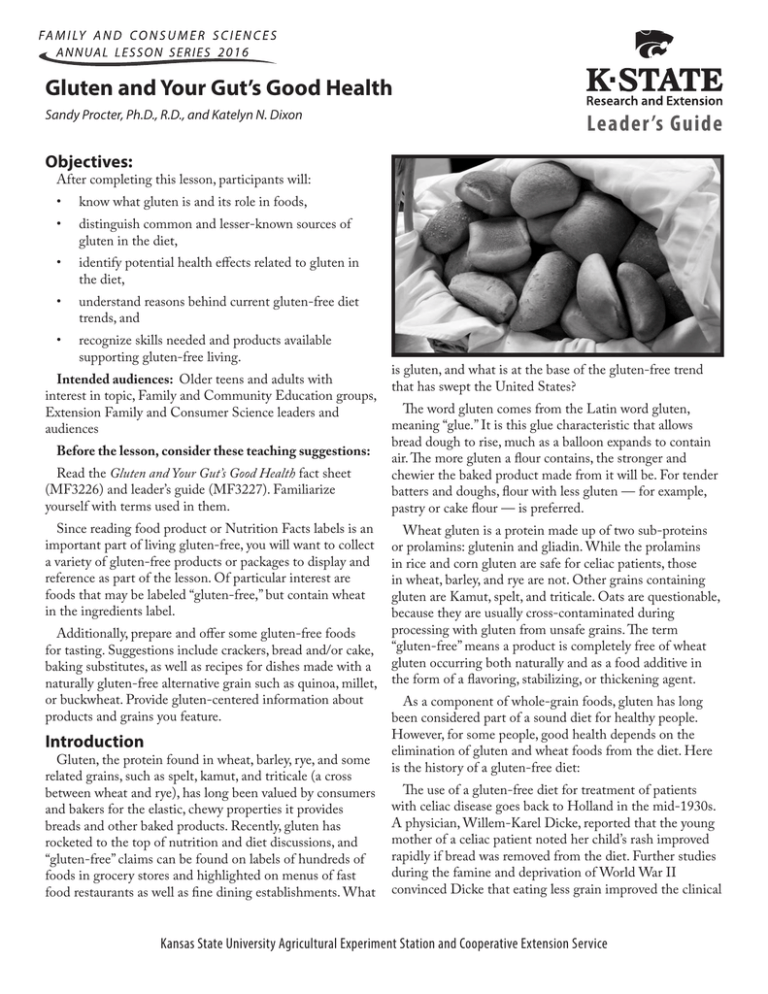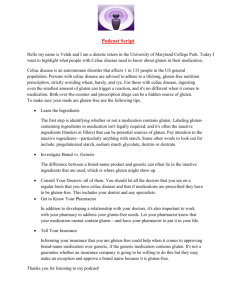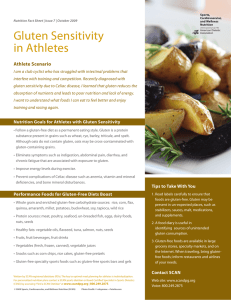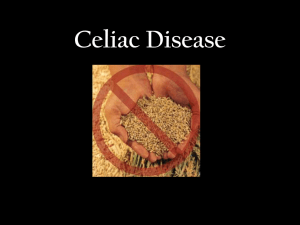
Gluten and Your Gut’s Good Health
Sandy Procter, Ph.D., R.D., and Katelyn N. Dixon
Leader ’s Guide
Objectives:
After completing this lesson, participants will:
•
know what gluten is and its role in foods,
•
identify potential health effects related to gluten in
the diet,
•
•
•
distinguish common and lesser-known sources of
gluten in the diet,
understand reasons behind current gluten-free diet
trends, and
recognize skills needed and products available
supporting gluten-free living.
Intended audiences: Older teens and adults with
interest in topic, Family and Community Education groups,
Extension Family and Consumer Science leaders and
audiences
Before the lesson, consider these teaching suggestions:
Read the Gluten and Your Gut’s Good Health fact sheet
(MF3226) and leader’s guide (MF3227). Familiarize
yourself with terms used in them.
Since reading food product or Nutrition Facts labels is an
important part of living gluten-free, you will want to collect
a variety of gluten-free products or packages to display and
reference as part of the lesson. Of particular interest are
foods that may be labeled “gluten-free,” but contain wheat
in the ingredients label.
Additionally, prepare and offer some gluten-free foods
for tasting. Suggestions include crackers, bread and/or cake,
baking substitutes, as well as recipes for dishes made with a
naturally gluten-free alternative grain such as quinoa, millet,
or buckwheat. Provide gluten-centered information about
products and grains you feature.
Introduction
Gluten, the protein found in wheat, barley, rye, and some
related grains, such as spelt, kamut, and triticale (a cross
between wheat and rye), has long been valued by consumers
and bakers for the elastic, chewy properties it provides
breads and other baked products. Recently, gluten has
rocketed to the top of nutrition and diet discussions, and
“gluten-free” claims can be found on labels of hundreds of
foods in grocery stores and highlighted on menus of fast
food restaurants as well as fine dining establishments. What
is gluten, and what is at the base of the gluten-free trend
that has swept the United States?
The word gluten comes from the Latin word gluten,
meaning “glue.” It is this glue characteristic that allows
bread dough to rise, much as a balloon expands to contain
air. The more gluten a flour contains, the stronger and
chewier the baked product made from it will be. For tender
batters and doughs, flour with less gluten — for example,
pastry or cake flour — is preferred.
Wheat gluten is a protein made up of two sub-proteins
or prolamins: glutenin and gliadin. While the prolamins
in rice and corn gluten are safe for celiac patients, those
in wheat, barley, and rye are not. Other grains containing
gluten are Kamut, spelt, and triticale. Oats are questionable,
because they are usually cross-contaminated during
processing with gluten from unsafe grains. The term
“gluten-free” means a product is completely free of wheat
gluten occurring both naturally and as a food additive in
the form of a flavoring, stabilizing, or thickening agent.
As a component of whole-grain foods, gluten has long
been considered part of a sound diet for healthy people.
However, for some people, good health depends on the
elimination of gluten and wheat foods from the diet. Here
is the history of a gluten-free diet:
The use of a gluten-free diet for treatment of patients
with celiac disease goes back to Holland in the mid-1930s.
A physician, Willem-Karel Dicke, reported that the young
mother of a celiac patient noted her child’s rash improved
rapidly if bread was removed from the diet. Further studies
during the famine and deprivation of World War II
convinced Dicke that eating less grain improved the clinical
Kansas State University Agricultural Experiment Station and Cooperative Extension Service
condition of his patients with celiac disease. In further
support of his theory, the patients’ health deteriorated
again when Allied planes started dropping bread in the
Netherlands. Dicke’s research on the effect of the glutenfree diet on patients with celiac disease continued until his
death in 1962.
Consider the health conditions that have traditionally
been treated with a gluten-free diet. The earliest noted
illness, and the most widely studied, is celiac disease.
Celiac disease
Celiac disease affects about 1 percent of the total
population, including about 3 million Americans. It is an
autoimmune disorder, and the only one where the trigger
is known. Celiac damages the villi of the small intestine,
resulting in decreased absorption of nutrients from food
due to an inflamed small bowel. The inflammation may
cause diarrhea, constipation, bloating, weight loss, irondeficiency anemia, osteoporosis, and has been shown to
slightly increase a celiac patient’s risk for bowel cancer. Not
everyone with celiac disease will experience the same, or in
some cases, any gastrointestinal symptoms.
Celiac is a genetic disorder, which means that more than
one family member may have symptoms, and the disease
is likely to pass along from one generation to the next.
Presently, there is no cure for celiac (sometimes spelled
“coeliac”) disease, but strict removal of gluten sources from
the diet decreases or eliminates the symptoms and halts the
damage the disease causes.
Dermatitis herpetiformis
This is a type of celiac disease that not only results
outwardly in a painful skin rash when gluten is eaten,
but also damages the small intestine of most people with
this condition. Blood tests and a skin biopsy are used to
accurately diagnose dermatitis herpetiformis. A gluten-free
diet is required to treat this form of the disease.
Non-celiac gluten sensitivity
Some people cannot tolerate gluten and experience
symptoms similar to persons with celiac disease, but do not
test positive for the disease itself. Unlike celiac, non-celiac
gluten sensitivity (abbreviated as NCGS and also called
gluten sensitivity) does not result in intestinal damage.
Many symptoms of NCGS are similar to those of celiac
disease, but research has shown that people with NCGS
report non-GI (gastrointestinal) symptoms that include
headache, joint pain, “foggy mind,” and numbness in the
legs, arms, or fingers. A major difference between the two
conditions is that non-celiac gluten sensitivity does not
result in increased intestinal permeability as celiac does,
so there is not the chance of infection from intestinal
contents seeping into the bloodstream. Instead, NCGS
often results in decreased intestinal permeability. This
decreased permeability or lowered ability for nutrients to
2
be absorbed from the gut may result in gastro-intestinal
symptoms including bloating, abdominal pain, and diarrhea.
Elimination of gluten from the diet brings relief from
symptoms for persons with gluten sensitivity.
Much research is currently focused on NCGS, its
increasing occurrence, and possible causes. Because of the
ambiguity of definition, the wide array of symptoms and
the difficulty in diagnosis, it is unclear just how widespread
NCGS may be. It is this lack of clarity that seems to be
key in today’s growing interest in gluten in the diet, though
eating certain carbohydrates as well as other parts of wheat
(besides gluten) may play a role in NCGS symptoms.
It is important that those who suspect they may have
one of the above conditions visit with their health-care
provider before starting a gluten-free diet. The diagnosis of
celiac disease, based on blood tests and a biopsy of the small
intestine, may not be accurate if a gluten-free diet is started
before testing. It is the practice of self-imposed gluten
elimination that has led to today’s diet trend. According
to some scientists examining the recent gluten-free trend,
what began as an interest in gluten could be evolving into
a misguided social health concern that gluten is toxic for
most of the population.
Wheat allergy
Different from both celiac disease and NCGS, wheat
allergy is an allergic reaction to wheat or its components,
such as starches, proteins, and even fat. A true wheat
allergy will bring about near-immediate or slightly delayed
symptoms following a wheat-containing meal. Like other
allergies, wheat allergy symptoms are often respiratory in
nature (nasal congestion, wheezing, watery eyes) but may
escalate to breathing difficulty and shock. People diagnosed
with wheat allergy need to avoid foods that contain wheat
ingredients. It is important to note that some gluten-free
foods may contain other wheat components, especially in
Europe and the United Kingdom.
In short, wheat allergy and gluten intolerance are
two completely different problems with similar, but not
K-State Research and Extension — Gluten and Your Gut’s Good Health, Leader’s Guide
identical, treatments. Because of the varied symptoms
different people experience with gluten intolerance, and
the overlap of symptoms with other health issues, accurate
diagnosis is difficult and may take years. It is the challenge
of diagnosis coupled with each individual’s motivation to
feel (and look) better that has in part fueled the huge recent
growth of “going gluten-free.”
Gluten-Containing Grains/
Thickeners
Gluten-Free Grains/
Thickeners
In August 2013, the Food and Drug Administration
(FDA) issued a final rule that defined what characteristics
a food needs in order to have a “gluten-free” label. The
rule also requires that foods labeled “without gluten,”
“free of gluten,” and “no gluten” follow the same standard.
Manufacturers and food processors had one year to bring
their labels into compliance. As of August 2014, any food
product bearing a gluten-free claim must meet the rule’s
requirements.
What is the definition of “gluten-free”? The FDA set a
gluten limit of less than 20 parts per million in foods that
carry this label. This level is at the low limit that gluten can
be detected in foods and is consistent with standards set by
other countries and international groups that establish food
safety standards. Additionally, a product may be labeled
gluten-free if it does not contain:
Wheat
Corn
Kamut
Rice
Spelt
Tapioca (cassava)
arley (malt, including malt
B
extract, malt vinegar)
Amaranth
Rye
Buckwheat
Farro
Arrowroot
Oats*
Millet
T riticale (a cross between
wheat and rye)
Montina
•
Lupine
•
Brewer’s yeast
Wheat starch (not processed)
Flax
Quinoa
Soy
Sorghum
Taro
Teff
Chickpea (gram flour)
*Technically, oats are gluten free but are often contaminated during
processing.
•
an ingredient that is any type of wheat, rye, barley, or
crossbreeds of those grains;
an ingredient derived from these grains and that has
not been processed to remove gluten; or
an ingredient derived from these grains and that has
been processed to remove gluten, if it results in the
food containing 20 or more parts per million gluten.
For those following a gluten-free diet, it is essential to read
product labels each time a food is purchased. Gluten may
be hidden in unexpected places (for example, in one variety
of pasta sauce but not another) and in nonfood items (for
example, certain lip gloss, play-dough type products, and
vitamin supplements), and product formulation may change
from one purchase to the next.
The gluten-free diet trend
Today’s widespread gluten-free trend can be traced
to several convergent factors. While many people who
avoid gluten find real relief from persistent, widely varied
symptoms, many others seem most strongly influenced by
numerous celebrities touting a gluten-free diet as a catch-all
solution to unspecified health issues, including excess body
weight. There are no published scientific reports supporting
the idea of weight loss as a result of a gluten-free diet in
people without celiac disease or gluten sensitivity. Research
continues to examine the health effects of gluten as part of
the human diet as well as the impact of its removal from
the diet.
The gluten-free diet’s popularity continues to explode. As
early as 2008, 15 percent to 25 percent of U.S. consumers
wanted gluten-free foods, and marketing researchers report
the gluten-free foods market is on target to exceed $6.6
billion by 2017. Though typically costlier than similar wheatbased products, gluten-free items are increasingly available on
grocery shelves, now often found alongside the original food
rather than tucked away in a special section of the store.
Terms defined
Autoimmune disorder — A condition in which a
person’s immune system attacks the body’s own cells,
causing tissue destruction.
Dermatitis herpetiformis (hur-peh-tuh-FOR-mis) —
A type of celiac disease that affects the skin and typically
also the small intestine.
K-State Research and Extension — Gluten and Your Gut’s Good Health, Leader’s Guide
3
Gluten (GLOO-tin) — The general name for proteins
found in wheat (durum, emmer, spelt, farina, faro, kamut,
Khorasan wheat, and einkorn), rye, barley, and triticale.
Triticale (trit i CAY lee) — A hybrid grain produced by
crossing wheat and rye.
NCGS — Non-Celiac Gluten Sensitivity — A
syndrome experienced by persons who react to dietary
gluten, without evidence of celiac disease or wheat allergy.
Acknowledgments
Special thanks to Janice Hermann, Ph.D., R.D.,
Oklahoma State University Extension, and Nozella
Brown, Ed.D., Family and Consumer Sciences Agent in
Wyandotte County, K-State Research and Extension, for
their careful and helpful reviews of this lesson.
Prolamin (PRO-luh-meen) — A plant storage protein
found in the seeds of cereal grains. Some prolamins, notably
gliadin (GLY-uh-din), may bring about celiac disease in
persons who are genetically predisposed.
References:
Adams, J. Willem-Karel Dicke: Pioneer in gluten-free diet in the
treatment of celiac disease. 2010. Accessed at http://www.Celiac.
com/articles/22013/l/Willem-Karel-Dicke-Pioneer-in-Gluten-freeDiet-in-the-treatment-of-Celiac-Disease/Page1.html on January 29,
2015.
Di Sabatino, A, Corassa, GR. “Nonceliac gluten sensitivity:
Sense or sensibility?” Ann Intern Med. 2012;156:309-311.
Gaesser GA, Angadi SS. “Gluten-free diet: Imprudent
dietary advice for the general population?” J Acad Nutr Diet.
2012;112(9):1330-1333.
McKindra, L. Agricultural Communications Services,
Oklahoma State University Division of Agricultural Sciences and
Natural Resources. Gluten-free diets not for everyone. Accessed at
http://www.dasnr.okstate.edu/Members/leilana.mckindra-40okstate.
edu/gluten-free-diets-not-for-everyone on February 5, 2015.
Office of the Federal Register. Vol. 78, 150, 47154-47179. Food
labeling; gluten-free labeling of foods. 08/05/2013. https://www.
federalregister.gov/articles/2013/08/05/2013-18813/food-labelinggluten-free-labeling-of-foods. Accessed on March 9, 2015.
Riddle, MS, Murray, JA, Porter, CK. “The incidence and
risk of celiac disease in a healthy US adult population.” Am J
Gastroenterol 2012;107:1248-1255.
Thompson, T. Celiac disease nutrition guide, 3rd ed. Academy of
Nutrition and Dietetics. 2014.
Volta, U, Caio, G, Tovoli, F, DeGiorgio, R. “Non-celiac gluten
sensitivity: questions still to be answered despite increasing
awareness.” Cellular & Molecular Immunology 2013; 10, 383-392.
Publications from Kansas State University are available at:
www.ksre.ksu.edu
Kansas State University Agricultural Experiment Station and
Cooperative Extension Service
Publications are reviewed or revised annually by appropriate faculty to
reflect current research and practice. Date shown is that of publication or
last revision. Contents of this publication may be freely reproduced for
educational purposes. All other rights reserved. In each case, credit Sandy
Procter, Ph.D., R.D., and Katelyn N. Dixon, Gluten and Your Gut’s Good
Health, Leader’s Guide, Kansas State University, July 2015.
K-State Research and Extension is an equal opportunity provider and
employer. Issued in furtherance of Cooperative Extension Work, Acts of
May 8 and June 30, 1914, as amended. Kansas State University, County
Extension Councils, Extension Districts, and United States Department
of Agriculture Cooperating, John D. Floros, Director.
MF3227 July 2015




